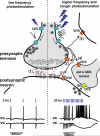What optogenetic stimulation is telling us (and failing to tell us) about fast neurotransmitters and neuromodulators in brain circuits for wake-sleep regulation
- PMID: 25064179
- PMCID: PMC4268002
- DOI: 10.1016/j.conb.2014.07.016
What optogenetic stimulation is telling us (and failing to tell us) about fast neurotransmitters and neuromodulators in brain circuits for wake-sleep regulation
Abstract
In the last eight years optogenetic tools have been widely used to identify functional synaptic connectivity between specific neuronal populations. Most of our knowledge comes from the photo-activation of channelrhodopsin-2 (ChR2) expressing inputs that release glutamate and GABA. More recent studies have been reporting releases of acetylcholine and biogenic amines but direct evidence for photo-evoked released of neuropeptides is still limited particularly in brain slice studies. The high fidelity in the responses with photo-evoked amino-acid transmission is ideal for ChR2-assisted circuit mapping and this approach has been successfully used in different fields of neuroscience. Conversely, neuropeptides employ a slow mode of communication and might require higher frequency and prolonged stimulations to be released. These factors may have contributed to the apparent lack of success for optogenetic release of neuropeptides. In addition, once released, neuropeptides often act on multiple sites and at various distances from the site of release resulting in a greater complexity of postsynaptic responses. Here, we focus on what optogenetics is telling us-and failing to tell us-about fast neurotransmitters and neuropeptides.
Copyright © 2014 Elsevier Ltd. All rights reserved.
Figures

References
-
- Scanziani M, Hausser M. Electrophysiology in the age of light. Nature. 2009;461:930–939. - PubMed
-
- Boyden ES, Zhang F, Bamberg E, Nagel G, Deisseroth K. Millisecond-timescale, genetically targeted optical control of neural activity. Nat Neurosci. 2005;8:1263–1268. - PubMed
-
- Petreanu L, Huber D, Sobczyk A, Svoboda K. Channelrhodopsin-2-assisted circuit mapping of long-range callosal projections. Nat Neurosci. 2007;10:663–668. - PubMed
Publication types
MeSH terms
Substances
Grants and funding
LinkOut - more resources
Full Text Sources
Other Literature Sources

